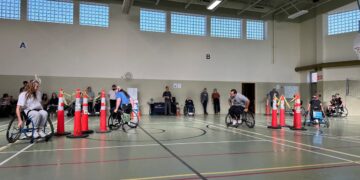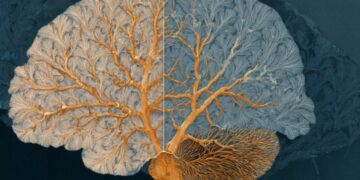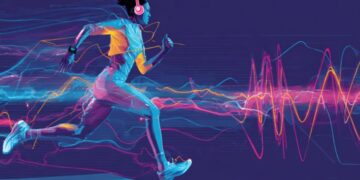Summary: Researchers found that the rhythm of everyday speech (including pauses, fillers, and subtle patterns) strongly reflects executive function, a key cognitive system that supports memory and flexible thinking. Using AI to analyze natural speech, the study showed that these linguistic features can predict performance on cognitive tests regardless of age, gender or education.
Because speech is easy to collect and free of practice effects, it offers a scalable way to monitor early brain changes related to dementia risk. The findings highlight natural speech as a promising tool for early detection and long-term monitoring of cognitive decline.
Key facts
Speech as a biomarker: Everyday timing patterns in speech predict executive function during adulthood. AI-powered insight: Machine learning models detected hundreds of subtle linguistic cues related to cognitive health. Early detection potential: Natural speech may enable scalable monitoring for people at high risk of dementia.
Source: Baycrest
The way we speak in everyday conversations may hold important clues about brain health, according to new research from Baycrest, the University of Toronto and York University.
The study found that subtle features of speech timing, such as pauses, fillers (“uh,” “um”), and difficulty finding words, are strongly related to executive function, the set of mental skills that support memory, planning, and flexible thinking.
The study is one of the first to demonstrate a direct link between natural speech patterns and essential cognitive functions, opening new avenues of research to better understand the mind. It builds on previous research that demonstrated that faster speaking speed is related to preservation of thinking in older adults (Wei et al., 2024).
“The message is clear: Speech timing is more than just a matter of style, it is a sensitive indicator of brain health,” says Dr. Jed Meltzer, senior scientist at Baycrest’s Rotman Research Institute and lead author of this study, titled “Natural speech analysis may reveal individual differences in executive function across the adult lifespan.”
Participants were asked to describe complex images in their own words while also completing standard tests of executive function.
Using artificial intelligence, the researchers analyzed the recordings and identified hundreds of subtle features, including pauses, filler words, and timing patterns. These characteristics reliably predicted performance on cognitive tests, even after accounting for age, sex, and education.
Executive functions decline with age and are often compromised in the early stages of dementia, but are difficult to track with traditional tests, which are time-consuming and vulnerable to practice effects, improvements in performance due to familiarity.
Natural speech, on the other hand, is an everyday behavior that can be measured repeatedly, discretely, and at scale. It also provides information on processing speed as a sensitive measure of cognitive integrity in an ecologically valid way, without the need to impose time limits, something that is difficult to capture with most traditional cognitive tasks.
Given the ease, convenience, and sensitivity of natural speech analysis, it is an ideal option for repeated assessments, which could identify individuals who are experiencing cognitive decline at a greater rate than expected and who may be at high risk of developing dementia.
“This research lays the groundwork for exciting opportunities to develop tools that could help track cognitive changes in clinics or even at home. Early detection is critical for any cure or intervention, as dementia involves progressive degeneration of the brain that can be slowed down,” says Dr. Meltzer.
The researchers emphasize the need for longitudinal studies, which follow individuals’ speech over time, to separate normal aging from the first signs of disease. They note that combining naturalistic speech with other measures could make early detection of cognitive decline more accurate and accessible.
Funding: This research was supported by the Mitacs Accelerate program and the Natural Sciences and Engineering Research Council of Canada (NSERC).
Key questions answered:
A: Subtle features of timing in everyday speech closely track executive function, a central marker of cognitive integrity.
A: It can be measured frequently, naturally and without testing pressures, revealing impairment sooner than traditional tasks.
A: Pauses, fillers, and timing patterns reliably predicted performance on tests of executive function throughout adulthood.
About this research news on speech and cognitive decline
Author: Natasha Nacevski-Laird
Source: Baycrest
Contact: Natasha Nacevski-Laird – Baycrest
Image: Image is credited to Neuroscience News.
Original Research: Closed access.
“Natural speech analysis may reveal individual differences in executive function across the adult lifespan” by Jed Meltzer et al. Journal of Speech, Language and Hearing Research
Abstract
Natural Speech Analysis May Reveal Individual Differences in Executive Function Across Adult Life
Aim:
Automated analysis of naturalistic speech has emerged as an effective tool for detecting cognitive decline in dementia, but has rarely been used to examine normal cognitive decline that occurs in normal aging.
Executive function (EF) declines across the adult lifespan, but is difficult to track longitudinally due to practice effects, making speech-based assessments particularly attractive. This study examined the relationships between EF and speech characteristics.
Method:
We collected two audio image descriptions from participants in two experiments that also included EF assessments, with 67 healthy older adults (aged 65 to 75 years) in Study 1 and 174 healthy adults (aged 18 to 90 years) in Study 2. Language composite scores were calculated by adding relevant speech features that index aspects of speech that have been reported to show changes in pathological aging.
Principal components reflecting common covariation in speech characteristics were extracted from a large training data set to calculate speech domain scores. Relationships between language compositions/major speech components and EF were assessed controlling for age, gender, and education.
Results:
In Study 1, older adults’ word-finding difficulties, measured as speech disfluencies, showed significant associations with EF. Study 2 confirms that speech disfluencies can explain individual differences in EF not only for adults over 65 years of age but also across the adult lifespan. Units of information and speech coherence showed weaker associations with EF and Montreal Cognitive Assessment scores that were not significant after correction for multiple comparisons.
Conclusion:
Findings revealed associations between word-finding ability in natural speech and general EF across the adult lifespan, supporting the analysis of natural speech as a convenient and sensitive assessment of general cognitive ability.

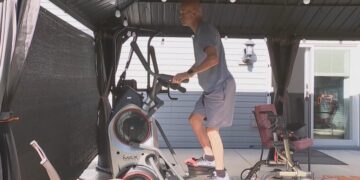



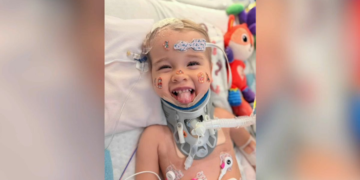
_6e98296023b34dfabc133638c1ef5d32-620x480.jpg)
